Contents
Potato is a traditional vegetable for s. It is grown in almost every garden, and with the advent of autumn they are put into bins for long-term winter storage. But unfortunately, potato tubers often turn black during storage. And even seemingly healthy vegetables in the cut can have black spots. Why potatoes turn black during storage for many farmers remains a mystery that must be unraveled. Otherwise, the problem will arise from year to year, destroying kilograms and tons of harvested crops.

Why do potatoes have dark spots (gray rot)
In the context of some tubers, blackening of the pulp can be seen. An example of such a change is shown in the photo above. This defect is a sign of gray rot tubers. It can occur due to a number of reasons. As a rule, they are associated with a violation of the mode of storage of vegetables or transportation. Experts identify 6 main reasons why potatoes turn black inside during storage:
Unbalanced soil composition
Many gardeners, in an effort to get a good harvest of vegetables, add a large amount of organic matter to the soil. It can be manure, herbal infusion or green manure. Such fertilizers contain a large amount of nitrogen, which accelerates the growth of plants and allows you to build up a large mass of tubers. However, it is a large amount of nitrogen that is the main reason that potato tubers turn black during storage.

This cause can be eliminated by proper fertilization:
- Fresh organics for potatoes can not be used. It should be well rotted. This applies not only to manure, but also green manure.
- The introduction of manure into the soil for growing potatoes is allowed no more than 1 time in 2 years.
Focusing on the use of nitrogen, many gardeners forget about such an important trace element as potassium. But it is potassium that allows the tubers to ripen in a timely manner and be safely stored in the winter. So, to prevent the blackening of tubers in the soil, it is necessary to regularly apply potash fertilizers.
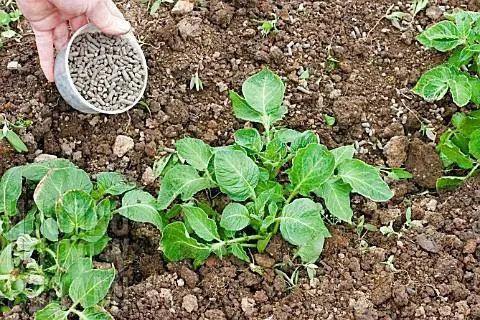
weather features
Potatoes prefer to grow in conditions with moderate temperature and humidity. Fluctuations in these indicators adversely affect the quality of tubers:
- high temperature leads to overheating of the tubers;
- low temperatures slow down the process of uptake of nutrients from the soil, resulting in the formation of small vegetables;
- lack of moisture dries out the tubers;
- excess moisture does not allow potatoes to breathe oxygen to the necessary extent, as a result of which various fungal and bacterial diseases and rot develop.
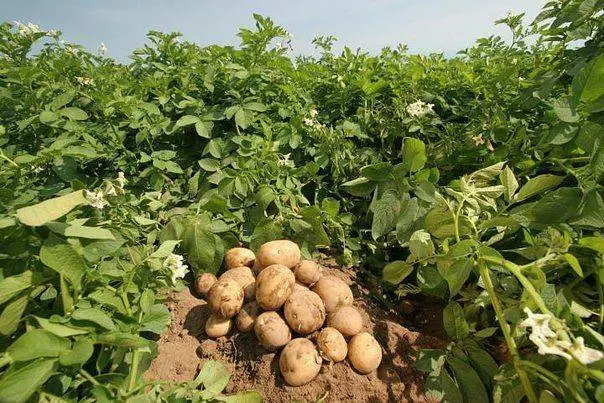
Each of these unfavorable conditions and their complex can lead to the fact that during storage the potatoes begin to turn black inside and lose their consumer qualities.
Untimely cleaning
It is necessary to harvest potatoes from the field on time. Every experienced farmer knows this rule. Harvesting an unripe crop and harvesting potatoes with the onset of frost can lead to sad consequences during storage:
- harvesting must be carried out in accordance with the characteristics of the variety. Too early harvesting of unripe tubers will most likely lead to blackening of the potatoes during storage;
- potatoes must be harvested from the fields before the first frost. Temperature even -10C can freeze the crop, causing it to rot in storage;
- in warm sunny weather, potatoes cannot be stored in the soil for a long time after mowing the tops. Without access to moisture, it can overheat;
- bags of potatoes should not be stored in conditions with high air temperature. Optimal mode for packaged vegetables +2-+40C.
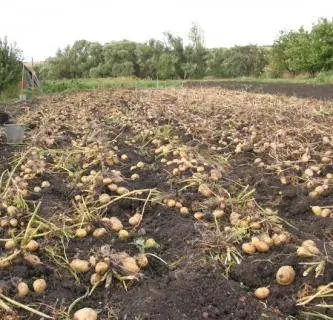
Timely harvesting of potatoes will reduce the likelihood of black spots inside the fruit during storage by 25%.
Mechanical damage
In the process of harvesting and transportation, potato tubers often hit, which leads to mechanical damage, bruises. The pulp in the deformed areas of the fruit may change color during storage. It is also important to remember that the damaged areas of the skin are the “gates” for various viruses, fungi, bacteria, which can provoke, among other things, putrefactive diseases of the root crop.
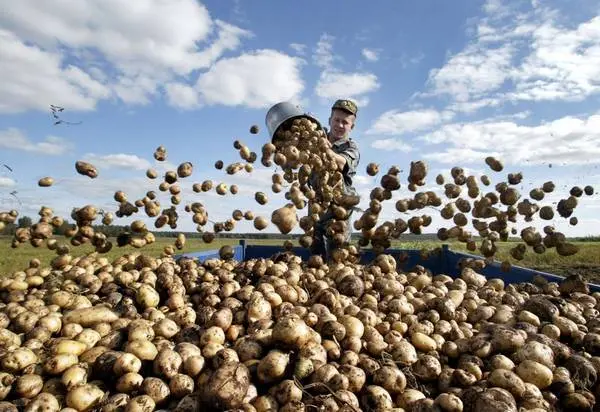
Great pressure on the lower layers of the potato can cause black spots to appear inside the fruit.
Storage Violation
You can store potatoes in a cellar or basement with a temperature of +1-+40C. Long-term storage of tubers at a temperature of 0 … -10C results in a sweet taste and dark spots inside the flesh. Too high storage temperature (more than +50) leads to rapid germination of tubers and the appearance of gray rot.
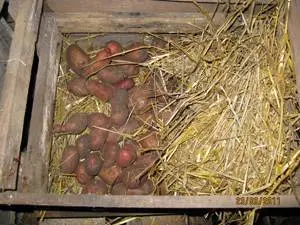
It is necessary to control the temperature in the storage regularly, however, special attention should be paid to this indicator in autumn and spring, when there is a change of seasons. You can regulate the temperature by opening (closing) air vents, ventilation, placing bottles with cold (hot) water around the perimeter of the room.
The most detailed information about all the features of storing potatoes can be found in the video:
Infectious diseases
A disease such as a black leg can affect not only tops, but also potato tubers. Moreover, the first symptoms of infection can appear only during the storage of the crop. A sign of the disease is rot, which quickly spreads from the stolon to the core of the tuber, covering the entire fruit. At the same time, rotting fruits exude an unpleasant characteristic odor. This black rot inside the potato is different from the usual gray spot. Its feature is the rapid spread within one tuber and infection of nearby vegetables.

It is worth noting that most often the potato turns black if it contains a large amount of starch. So, slightly blackened pulp is the norm for some varieties of potatoes.
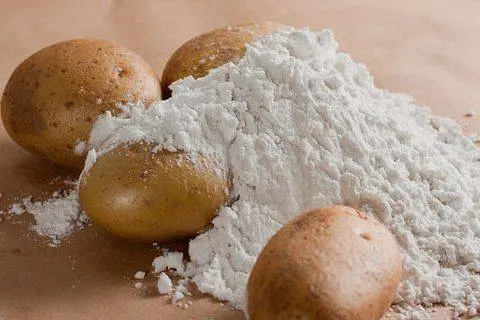
Conclusion
So that the potatoes do not turn black during storage, it is necessary to strictly follow the rules for growing crops and ensure an optimal microclimate in the cellar. For preventive purposes, it is necessary to apply potash fertilizers to the soil at a late stage of plant vegetation. It is possible to smooth out the negative impact of weather conditions during cultivation if the soil is loosened, weeded, and hilled in a timely manner. With maximum effort and attention, it will certainly be possible not only to grow a good crop of potatoes, but also to keep it without loss of quality until late spring.









